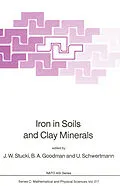Probably more than any other element, iron markedly influences the chemical and physical properties of soils and sediments in the earth. Considering its transition metal status, with potential variation in electronic configuration, ionic radius, and magnetic moment, combined with its abundance and relatively large mass, little wonder that one sees its unique influence on every hand. Pre sentations at the NATO Advanced Study Institute (NATO AS!) on Iron in Soils and Clay Minerals reviewed and discussed the occurrence, behavior, and properties of Fe-bearing minerals found in soils and in the clay mineral groups kaolinite, smectite, and mica. Also discussed at the NATO AS! were the basic chemical properties of Fe, methods for separating and identifying Fe in minerals, and the role of Fe minerals in weathering and other soil-forming processes. The present publication is the reviewed and edited proceedings of that Advanced Study Institute. The sequence of chapters follows the general pattern beginning with introductory chapters which overview the general occurrence of Fe in the earth and its chemistry, both generally and in mineral environments, followed by identification and characterization methods for Fe and Fe phases in minerals. The properties and behavior of Fe oxides, Fe-bearing clay minerals, and other Fe minerals in soils are then described, and the text ends with a summary of the role of Fe in soil-forming processes. A Table of Contents and subject index are provided to assist the reader in finding specific topics within the text.
Inhalt
1. The Geobiochemical Cycle of Iron.- 1-1. Geochemical Characterization of Iron.- 1-2. Geochemical Behavior of Iron in the Weathering Environment.- 1-3. Iron in Organisms and Soil Organic Matter.- 1-3.1. Fe-Bearing Compounds in Organisms.- 1-3.2. Quantitative Relationships.- Literature Cited.- 2. An Introduction to Physical and Chemical Principles.- 2-1. Introduction.- 2-2. Nuclear Properties'and their Importance in Spectroscopy.- 2-3. Electronic Properties - Free Ions.- 2-4. Electronic Properties - Crystal Field Theory.- 2-5. Electronic Properties - Molecular Orbital Theory.- Literature Cited.- 3. Solubility and Redox Equilibria of Iron Compounds in Soils.- 3-1. Introduction.- 3-2. Equilibrium Reactions of Iron.- 3-3. Solubility of Iron(III) Oxides in Soils.- 3-4. Other Iron(III) Minerals.- 3-5. Hydrolysis of Iron(III).- 3-6. Other Iron(III) Complexes in Soils.- 3-7. Effect of Redox on Iron(II) Solubility.- 3-8. Effect of Redox on Total Iron Solubility.- 3-9. Electron Titration of Soils.- 3-10. Effect of Redox on Smectite Stability.- 3-11. Role of Chelation in Iron Solubility.- 3-11.1. Measuring Fe3+ Solubility in Soils.- 3-11.2. Role of Chelation in Iron Availability.- 3-12. Problems.- Literature Cited.- 4. Separation and Concentration of Iron-Containing Phases.- 4-1. Introduction.- 4-2. Physical Separation Procedures.- 4-2.1. Manual Separation of Iron-Rich Areas.- 4-2.2. Wet Sieving to Concentrate Iron-Rich Concretions.- 4-2.3. Particle Size Separation.- 4-2.4. Density Gradient Separation.- 4-2.5. Magnetic Separation.- Hand Magnet.- High Gradient Magnetic Separation.- 4-3. Chemical Separation Procedures.- 4-3.1. Dissolution of Aluminosilicates Using Strong Bases.- Acknowledgments.- Literature Cited.- 5. Phase Identification by Selective Dissolution Techniques.- 5-1. Introduction.- 5-1.1. Specificity and Selectivity.- 5-2. Dissolution Techniques.- 5-2.1. The Pyrophosphate Technique(s).- 5-2.2. The Oxalate Technique.- 5-2.3. The EDTA Technique.- 5-2.4. The Dithionite-Citrate-Bicarbonate Technique.- 5-3. Concluding Remarks.- Literature Cited.- 6. The Assay for Iron in Soils and Clay Minerals.- 6-1.Introduction.- 6-2. Preliminary Considerations.- 6-3. Sampling.- 6-4. Sample Preparation.- 6-5. Selective Dissolution.- 6-6. Total Dissolution.- 6-6.1.Hydrogen Peroxide.- 6-6.2. Acids.- 6-6.3. Ashing.- 6-6.4.Decomposition with Mineral Acids.- 6-6.5. Fusions.- 6-6.6.Resistant Minerals.- 6-6.7. Iron(II).- 6-7. The Determination of Iron.- 6-7.1. Titrimetry.- 6-7.2.Colorimetry.- 6-7.3.Electrical.- 6-7.4.Instrumental Analysis.- 6-8. Precision, Accuracy, and Reference Materials.- Acknowledgements.- Literature Cited.- 7. Introduction to Crystal Structures of Iron-Containing Minerals.- 7-1.Introduction.- 7-2. Chain Silicates.- 7-2.1. Olivine.- 7-2.2.Pyroxenes.- 7-2.3.Amphiboles.- 7-2.4.Garnet.- 7-3. Phyllosilicate Clay Minerals.- 7-4. Iron Oxides.- 7-3.1.Hematite.- 7-3.2.Umenite.- 7-3.3.Magnetite.- 7-3.4.Maghemite.- 7-3.5. Goethite.- 7-3.6.Lepidocrocite.- 7-3.7.Akaganéite.- 7-3.8.Ferrihydrite and Feroxyhite.- Acknowledgements.- Literature Cited.- 8. The Application of Micro-Beam Methods to Iron Minerals in Soils.- 8-1.Introduction.- 8-2. Diffraction Theory.- 8-3. X-ray Diffraction.- 8-3.1.Mineral Identification.- 8-3.2. Crystal Size Estimation.- 8-3.3.Unit Cell Dimensions.- 8-3.4.Examples.- Goethite.- Lepidocrocite.- Hisingerite.- Nontronite.- 8-4. Transmission Electron Microscopy.- 8-4.1. Electron Diffraction.- Selected Area Diffraction (SAD).- Single-Crystal Diffraction.- 8-4.2. Electron Imaging.- Bright Field.- Dark Field.- n-Beam Images - High Resolution TEM.- 8-4.3. Specimen Preparation.- Grain Mounts.- Ion Thinning.- Microtomed Sections.- 8-4.4. Examples.- Goethite.- Hisingerite.- Ferrihydrite.- Iron Mineral Formation in Weathering.- 8-4.5. Analytical Electron Microscopy.- Literature Cited.- 9. Some Properties of Soil and Synthetic Iron Oxides.- 9-1.Introduction.- 9-2. Color.- 9-3. Crystal Morphology and Size.- 9-3.1. General Morphology.- 9-3.2.Crystal Size and Morphological Variations.- Electron Microscopy.- X-ray Diffraction.- 9-3.3.Môssbauer Spectroscopy.- 9-4. Surface Area.- 9-4.1.Gas and Dipole Adsorption.- 9-4.2.Phosphate Adsorption.- 9-4.3. X-ray Diffraction Line Broadening.- 9-5. Isomorphous Substitution.- 9-5.1. Aluminum.- 9-5.2. Other Metals.- 9-6. Thermal Behavior.- 9-7. Dissolution Kinetics.- 9-9. Interactions with Clay Silicates.- 9-10. Future Work.- Literature Cited.- 10. Introduction to the Surface Charge Properties of Iron oxides and Oxidic Soils.- 10-1. Introduction.- 10-2. Charging Phenomena at Iron Oxide Interfaces.- 10-2.1. Charge Development in the Presence of Indifferent Electrolytes.- 10-2.2. Charge Development in the Presence of Specifically Adsorbed Ions.- 10-2. Surface Charge Characteristics of Highly Weathered Soils Rich in Oxides.- Literature Cited.- 11. Occurrence and Formation of Iron Oxides in Various Pedoenvironments.- 11-1. Introduction.- 11-1.1. Role of Iron(III) Oxides in Pedogenesis.- 11-1.2. Basic Reactions.- 11-1.3. Ways to Study the Relationship Between Iron(III) Oxides and Pedoenvironments.- 11-2. Pedoenvironments and Iron(III) Oxide Minerals.- 11-2.1. The Goethite-Hematite Pair.- Soil Temperature and Soil Water Activity.- Organic Matter.- Soil Acidity.- Aluminum.- Mechanism of Hematite and Goethite Formation from Ferrihydrite.- Conclusions.- 11-2.2. Lepidocrocite.- Occurrence in Various Soils.- The Lepidocrocite-Goethite Pair.- Conclusions.- 11-2.3. Ferrihydrite.- General Remarks.- Formation in Various Pedoenvironments.- Conclusions.- 11-2.4. Maghemite and Magnetite.- Maghemite.- Magnetite.- 11-3. Pedoenvironments and Aluminum Substitutions.- 11-3.1. General Remarks.- 11-3.2. Goethite.- 11-3.3. Hematite and Other Iron(III) Oxides 301.- 11-4. Conclusions and Future Work.- Literature Cited.- 12. Properties and Behavior of Iron Oxides as Determined by Mossbauer Spectroscopy.- 12-1. Principles of Mossbauer Spectroscopy.- 12-1.1 Introduction.- 12-1.2. Hyperfine Interactions.- 12-2. Effects of Magnetic Properties on Mossbauer Spectroscopy.- 12-2.1. The Neel Temperature and the Magnetic Hyperfine Field.- 12-2.2. The Quadrupole Interaction in Magnetically Ordered Materials.- 12-2.3. Nonideal Behavior: Superparamagnetic Relaxation and Related Phenomena.- 12-3. Variatons of the Magnetic Hyperfine Field in Crystalline Iron Oxides.- 12-3.1. Influence of A1 S…
